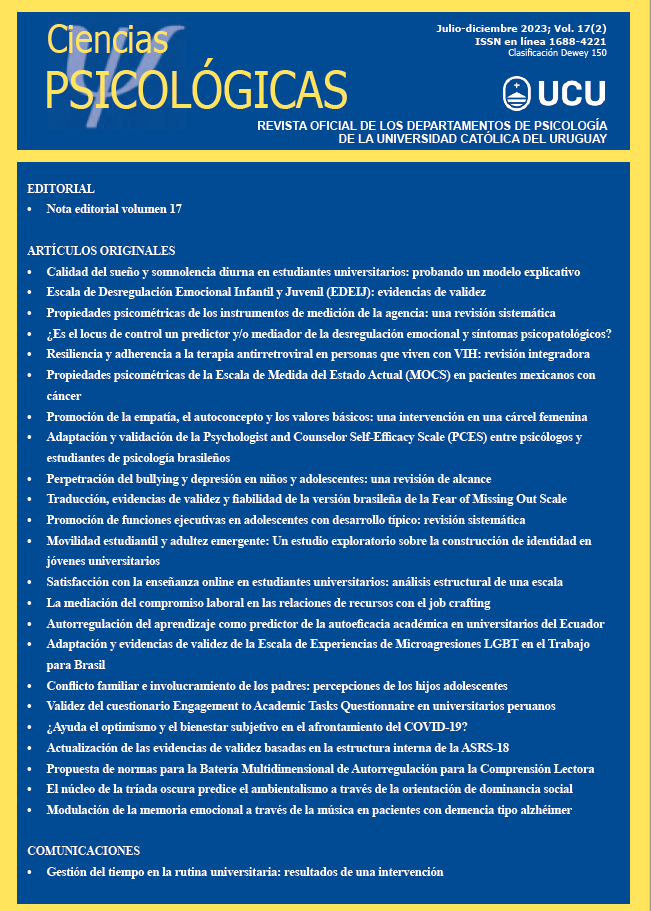Tradução, evidências de validade e fiabilidade da versão brasileira da Fear of Missing Out Scale
DOI:
https://doi.org/10.22235/cp.v17i2.2835Palavras-chave:
Fear of Missing Out, propriedades psicométricas, análise fatorialResumo
O Fear of Missing Out (FoMO), descrito como um desconforto causado pela sensação de estar excluído ou não participar de atividades nas quais os colegas estejam envolvidos, é analisado neste estudo. A Escala FoMO, composta por 10 itens, é empregada para mensurar os níveis desse sentimento. O objetivo da pesquisa consistiu em realizar a tradução, adaptação e validação da Fear of Missing Out Scale para o cenário brasileiro. Para alcançar esse propósito, o estudo seguiu duas etapas metodológicas distintas: a primeira diz respeito à tradução e adaptação, enquanto a segunda abrangeu a aplicação da escala, acompanhada da análise das evidências de validade de conteúdo e construto. Na primeira fase, o processo compreendeu a tradução propriamente dita, seguida pela tradução reversa e subsequente avaliação por parte de especialistas e do público-alvo. Já na segunda etapa, conduziu-se uma análise fatorial exploratória (AFE) utilizando o software Factor, que envolveu 646 participantes, com idades entre 18 e 63 anos (M = 32,60; DP = 11,84). A análise fatorial exploratória apontou para a presença de uma única dimensão na escala, em concordância com a estrutura original da mesma. Além disso, o estudo apresentou duas formas de evidência de validade para o instrumento, considerando sua aplicação inédita no contexto brasileiro. A possibilidade de utilizar a escala nesse cenário possibilita a realização de estudos transculturais abordando esse tema.
Downloads
Referências
Al-Menayes, J. (2016). The fear of missing out scale: Validation of the Arabic version and correlation with social media addiction. International Journal of Applied Psychology, 6(2), 41-46.
Alt, D. (2015). College students' academic motivation, media engagement and fear of missing out. Computers in Human Behavior, 49, 111-119. https://doi.org/10.1016/j.chb.2015.02.057
Borsa, J. C.; Damásio, B. F.; Bandeira, D. R. (2012). Adaptação e validação de instrumentos psicológicos entre culturas: algumas considerações. Paidéia, 22(53), 423-432. https://doi.org/10.1590/s0103-863x2012000300014
Brown, T. A. (2006). Confirmatory factor analysis for applied research. The Guilford Press.
Casale, S., & Fioravanti, G. (2015). Satisfying needs through social networking sites: A pathway towards problematic Internet use for socially anxious people? Addictive Behaviors Reports, 1, 34-39. https://doi.org/10.1016/j.abrep.2015.03.008
Casale, S., & Fioravanti, G. (2020). Factor structure and psychometric properties of the Italian version of the fear of missing out scale in emerging adults and adolescents. Addictive Behaviors, 102, 106179. https://doi.org/10.1016/j.addbeh.2019.106179
Elhai, J. D., Yang, H., Fang, J., Bai, X., & Hall, B. J. (2020). Depression and anxiety symptoms are related to problematic smartphone use severity in Chinese young adults: Fear of missing out as a mediator. Addictive behaviors, 101, 105962. https://doi.org/10.1016/j.addbeh.2019.04.020
Ferrando, P. J., & Lorenzo-Seva, U. (2018). Assessing the quality and appropriateness of factor solutions and factor score estimates in exploratory item factor analysis. Educational and Psychological Measurement, 78, 762-780. https://doi.org/10.1177/0013164417719308
Floyd, F. & Widaman, K. (1995). Factor analysis in the development and refinement of clinical assessment instruments. Psychological Assessment, 7, 286-299. https://doi.org/10.1037/1040-3590.7.3.286
Gil, F., Del Valle, G., Oberst, U., & Chamarro, A. (2015). Nuevas tecnologías -¿Nuevas patologías? El smartphone y el fear of missing out. Aloma: Revista de Psicologia, Ciències de l’Educació i de l’Esport, 33(2), 77-83. https://doi.org/10.51698/aloma.2015.33.2.77-83
Gökler, M., Aydın, R., Unal, E., & Metintas, S. (2016). Determining validity and reliability of Turkish version of Fear of Missing out Scale. Anatolian Journal of Psychiatry, 17(1), 53. https://doi.org/10.5455/apd.195843
Laros, J. A. (2005). O uso da análise fatorial: algumas diretrizes para pesquisadores. Análise fatorial para pesquisadores, 1, 145.
Lorenzo-Seva, U., & Ferrando, P. J. (2019). Robust Promin: a method for diagonally weighted factor rotation. Liberabit: Revista Peruana de Psicología, 25(1), 99-106. https://doi.org/10.24265/liberabit.2019.v25n1.08
Milyavskaya, M., & Koestner, R. (2011). Psychological needs, motivation, and well-being: A test of self-determination theory across multiple domains. Personality and Individual Differences, 50(3), 387-391. https://doi.org/10.1016/j.paid.2010.10.029
O’Connor, B. P. (2000). SPSS and SAS programs for determining the number of components using parallel analysis and Velicer's MAP test. Behavior Research Methods, Instrumentation, and Computers, 32(3), 396-402. https://doi.org/10.3758/bf03200807
Pasquali, L. (2009). Psicometria. Revista da Escola de Enfermagem da USP, 43(spe), 992-999. https://doi.org/10.1590/s0080-62342009000500002
Perrone, M. A. (2013). #FoMO: establishing validity of the fear of missing out scale with an adolescent population. Alfred University.
Przybylski, A. K., Murayama, K., DeHaan, C. R., & Gladwell, V. (2013). Motivational, emotional, and behavioral correlates of fear of missing out. Computers in Human Behavior, 29, 1841-1848. https://doi.org/10.1016/j.chb.2013.02.014
Reeve, J. (2006). Motivação e Emoção (4a ed.). LTC.
Roberts, J. A., & David, M. E. (2020). The social media party: Fear of missing out (FoMO), social media intensity, connection, and well-being. International Journal of Human–Computer Interaction, 36(4), 386-392. https://doi.org/10.1080/10447318.2019.1646517
Ryan, R. M., & Deci, E. L. (2000). Self-determination theory and the facilitation of intrinsic motivation, social development, and well-being. American Psychologist, 55(1), 68-78. https://doi.org/10.1037/0003-066x.55.1.68
Sette, C. P., Lima, N. R., Queluz, F. N., Ferrari, B. L., & Hauck, N. (2020). The online fear of missing out inventory (ON-FoMO): Development and validation of a new tool. Journal of Technology in Behavioral Science, 5(1), 20-29. https://doi.org/10.1007/s41347-019-00110-0
Skierkowski, D., & Wood, R. M. (2012). To text or not to text? The importance of text messaging among college-aged youth. Computers in Human Behavior, 28, 744-756. https://doi.org/10.1016/j.chb.2011.11.023
Tanhan, F., Özok, H. İ., & Tayiz, V. (2022). Fear of missing out (FoMO): A current review. Psikiyatride Guncel Yaklasimlar, 14(1), 74-85.
Timmerman, M. E., & Lorenzo-Seva, U. (2011). Dimensionality Assessment of Ordered Polytomous Items with Parallel Analysis. Psychological Methods, 16, 209-220. https://doi.org/10.1037/a0023353
Wegmann, E., Oberst, U., Stodt, B., & Brand, M. (2017). Online-specific fear of missing out and Internet-use expectancies contribute to symptoms of Internet-communication disorder. Addictive Behaviors Reports, 5, 33-42. https://doi.org/10.1016/j.abrep.2017.04.001
Downloads
Publicado
Como Citar
Edição
Secção
Licença
Direitos de Autor (c) 2023 Universidad Católica del Uruguay

Este trabalho encontra-se publicado com a Licença Internacional Creative Commons Atribuição 4.0.


















